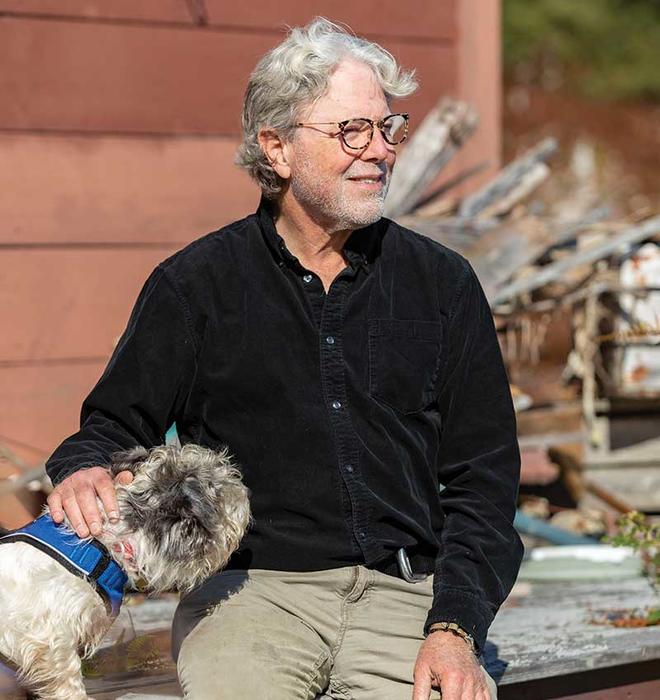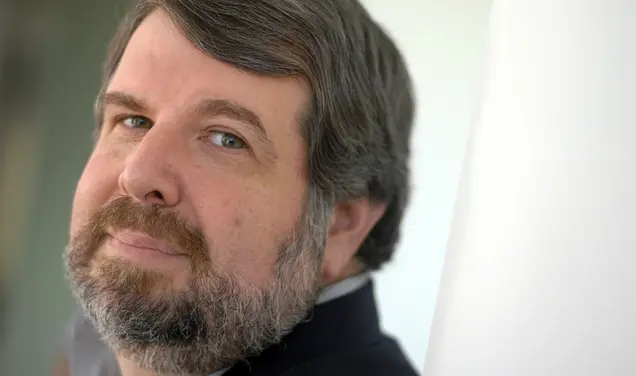
Chronicler of the Natural World
Richard Preston *83 writes about nature’s power, from viruses to the tallest trees
To much of the world, the advent of the novel coronavirus was an inconceivable calamity. To Richard Preston *83, it was more like the future foretold. For the past quarter century, Preston, the best-selling author of nonfiction thrillers like The Hot Zone, has anticipated just such a global plague — or one even worse — and has done as much as anyone to sound the alarm. In the preface to Crisis in the Red Zone, his riveting account of the 2014 Ebola virus outbreak in West Africa, published last year, Preston warned that the world had just witnessed the “most destructive rapid epidemic in anyone’s lifetime,” a disaster that “may be an example of things to come.” He takes no pleasure in having been more right than he’d like to be.
“People are human beings all over the world, and the common American reaction to the virus has been very much like the common African reaction to Ebola,” he tells me. “An awful lot of people in the United States, including our president, claimed initially ... that it was nothing to worry about. And it’s natural to deny the existence of a plague.”
Preston lives in Hopewell, near Princeton, where for exercise he climbs a tree in the afternoons, “weather permitting.” It’s a “huge red oak named Circe,” he says, after the sorceress of Greek mythology who turned men into animals. But when we spoke by phone in September, he was contemplating COVID-19 from Louds Island off the central Maine coast, where he is renovating an old house in an isolated redoubt with no mail boat, no ferry service, nothing but solar panels for electricity and a deeded 19th-century bucket well and rooftop rain collection for fresh water. It turns out that one of the most erudite science writers of our time had learned something new: To charge a bucket with well water, you have to throw it upside down on a slack rope to the bottom; if you lower it slowly, it will float upright and not fill
It’s just a coincidence that Preston happened to be at work about as far from the thick of the hot, crowded modern world as it is possible to get (he has a family home on the mainland nearby), but it was not lost on him that a 3-mile-long island with only a dirt track for a road was a decent place to alight in the midst of a global pandemic. He notes that it took tragic experience with Ebola to teach Africans that the only way to fight an invisible and highly contagious virus was with compulsive hand-washing, rigorous biohazard safety protocols, and extreme social distancing of the sort that once banished smallpox sufferers to the outskirts of tribal villages in an unbending application of what Preston calls “the ancient rule.”
“People understood that you simply had to isolate the sick or there was no other way to stop the virus,” he says. “And this is a hard lesson for Americans to learn. It’s been very difficult for Americans to take seriously the threat of coronavirus and to practice the ancient rule, to isolate themselves from other people and to stay away from large sporting events and motorcycle rallies, and to wear masks.”
Preston has built a career as a reigning chronicler of the dangers — and beauties — of the natural world. His 10 books have been translated into more than 30 languages. While nonfiction is his métier, his books read like novels, and he was chosen by the estate of Michael Crichton to complete Micro, Crichton’s last thriller, still unfinished at his death in 2008. The book was published three years later.
Preston’s reporting technique is boldly participatory. He combed a Kenyan cave in search of a deadly virus, braved the sealed rigors of Level 4 biohazard containment suites and, for The Wild Trees, his 2007 book about the intrepid botanists and arborists who study California’s massive coast redwoods, climbed some of the largest trees on Earth. Two hundred fifty feet in the air, Preston writes, he found “a world between the ground and the sky, an intermediary realm, neither fully solid nor purely air, an ever-changing scaffold joining heaven and earth, ruled by the forces of gravity, wind, fire, and time.”
Nothing about this professional path was preordained. Preston grew up in Wellesley, Mass., the son of a father who practiced law and a mother who taught art history, and he came to Princeton as a graduate student in English after earning his undergraduate degree at Pomona College. He wrote his Ph.D. dissertation on 19th-century nonfiction under the direction of professors William Howarth and the late Emory Elliott — and with the additional guidance of the faculty member who became a crucial mentor, sponsor, and close friend: John McPhee ’53. Preston became only the second graduate student admitted to McPhee’s celebrated class, “The Literature of Fact,” and Preston recalls that Howarth had confided that McPhee worried that having graduate students “would be pretentious and disruptive.” Preston promised that he would be neither, and McPhee relented. The professor was not wild about Preston’s first assignment, a mini-profile of classmate Eric Schlosser ’81, the future author of Fast Food Nation. “He wrote, ‘Richard, this is long, and I don’t mean in length.’ Meaning it’s boring,” Preston remembers.
Schlosser’s memory of Preston’s performance in class is decidedly different. “Preston was older than us, smarter than us, and a better writer than us,” Schlosser tells me. “We sometimes had to read our pieces out loud during McPhee’s class, and Preston’s were dazzling — and really well-delivered.” For his part, McPhee would come to appreciate Preston’s “inherent dramatic flair” even in his student work, such as a piece about a “blaster,” a construction demolition expert. “He sees a story wherever he looks and translates that into his writing.”
Preston bypassed the academic job market to pursue a career as a freelance writer. He made ends meet by working in Princeton’s development office, drafting case statements for President William G. Bowen *58, but struggled. He married fellow English Ph.D. student Michelle Parham *86, who would soon become the first female editor of PAW.
It was another Princeton connection that gave Preston his first professional break, when he wrote about astronomy professor James Gunn, now emeritus. In the early 1980s, Gunn pioneered the use of special integrated circuits to increase the sensitivity of the 5-meter Hale telescope at the California Institute of Technology’s Palomar Observatory. The story of Gunn’s work is told in First Light, Preston’s first book, published by the Atlantic Monthly Press in 1987. The same year, thanks to McPhee’s longstanding relationship with The New Yorker, Preston wrote his first piece for the magazine, a review of a recently published collection of works by the 19th-century historian Francis Parkman. The assigning editor rejected the piece, and no one else liked it, either — except the magazine’s legendary editor William Shawn, who promptly ran it. It marked the start of Preston’s own long-running work for the magazine, in which he has covered an eclectic range of topics from mathematics to steel manufacturing, biomedicine, and disease.
“I first fell for Dick’s work when I read his amazing and gloriously strange profile of the Ukrainian émigré computer scientists who, in a tiny room packed with overheating computers, try to figure out the maximal digits to the infinite pi — the Chudnovsky brothers,” says The New Yorker’s current editor, David Remnick ’81. The Chudnovskys are world-class mathematicians, and Preston’s 1992 article recounted how they calculated pi to some 2 billion digits on a supercomputer they’d built in their Manhattan apartment. Preston described the brothers’ crammed workspace with sly wit: “The bookshelves extend into every corner of the apartment, and today they are packed with literature and computer books and books and papers on the subject of numbers. Since almost all numbers run to infinity (in digits) and are totally unexplored, an apartmentful of thoughts about numbers holds hardly any thoughts at all, even with a supercomputer on the premises to advance the work.”
“It was a piece of writing with everything,” Remnick adds. “A story of obsession, a wealth of learning lightly applied, hilarious but not cartoonishly drawn characters ... . The thing is, Dick can cook the most astonishing meals because he has done the prep work — the reporting, the thinking, the structural considering — with the kind of care that you associate with, well, John McPhee.”
It was a New Yorker article that spawned The Hot Zone, Preston’s breakthrough 1994 No. 1 bestseller, about an Ebola outbreak at a laboratory-monkey facility in suburban Virginia in 1989–90. The outbreak had been successfully contained by the U.S. Army without fatalities and was all but forgotten by the public by the time Preston resolved to reconstruct it. He did so in terms so vivid as to raise your neck hairs all these years later, as in this description of the virus’s destructive power: “Your body becomes a city under siege, with its gates thrown open and hostile armies pouring in, making camp in the public squares and setting everything on fire; and from the moment Ebola enters your bloodstream, the war is already lost; you are almost certainly doomed.”
Preston’s methods are low-tech and meticulous. He doesn’t use a tape recorder, but takes pencil notes in “little CVS pocket notebooks,” interviewing his living subjects over and over again to capture the voices, their mannerisms, their body language, their firsthand stories of events long past; prodding them (and everyone they know) for fine-grained memories. In the case of subjects he has never met — as with the fearless international group of medical workers who died in the 2014 Ebola outbreak in Africa — he deploys the same techniques with their surviving friends and families, relying when possible on emails and time-stamped text messages to re-create the past. For Crisis in the Red Zone, he created a detailed timeline of the action, down to the minute and second in some cases — an outline that ultimately ran to 75,000 words, about half the length of the book. “If you ask a person, ‘What were you thinking?’” he writes in a note to the reader at the beginning of The Hot Zone, “you may get an answer that is richer and more revealing of the human condition than any stream of thoughts a novelist could invent.”
That’s not the end of the effort. “And then I refine the portrait,” Preston says. “Sometimes my subjects will say, ‘No, that’s not quite right.’ And these changes occur in manuscript, toward the end of the process. My writing tends to drive editors and publishers totally insane because I’m still doing fact-checking in page proofs, when you’re not supposed to be doing anything more than changing commas.”
In the case of COVID-19, Preston says, “I don’t know how it’s going to play out,” but he believes the early critical experience of New York City should be instructive. “When New Yorkers began to hear sirens all night, all around them, and when they realized that hospitals were completely filled with extremely sick COVID patients, and when they perceived that people they knew were getting COVID and just ending up sick or dying, New Yorkers realized, as Africans in urban areas did [with Ebola], that the virus was real and an extremely dangerous virus.”
Asked if he plans to write about the coronavirus, he says probably not. “I’m not sure that I could really contribute anything completely meaningful.” But in the next breath, he adds that he does have some meaningful perspective to offer: “We don’t perceive it, but what we are experiencing is, in effect, the revenge of nature,” in packed cities across the globe, with no immunity, he explains. He offers a back-of-the-envelope calculation, noting that the coronavirus is such a tiny organism that about 10 billion particles can fit on the head of a pin 1 millimeter in diameter; 800 of them lined up together would span the thickness of a human hair. By the time we talked this fall, he guessed, roughly 50 million people on the planet had probably already been infected, assuming that the real count far exceeded the official number of reported cases, with no end in sight. So, in Preston’s estimate, what was the amount of virus that had actually been created in the human population by then? “A cube about 4 1/2 inches on a side; that’s what we’re talking about here. A minute organism, a very, very small amount of this organism, has changed the lives of virtually every person on the planet.”
Preston’s journey has taken him to the farthest corners of the Earth — thousands of miles from Cleveland Tower and the Graduate College, but he says “a day does not go by” when he doesn’t call on some aspect of the education he received there. And in the end, he hasn’t really strayed so far from the highest literary ambitions that drew him to Princeton in the first place. “What fascinates me and what I write about is the relationship of the human species to nature,” he says. “I’m fascinated with nature in its own right as the ‘other.’ Nature is not human. Nature is incredibly beautiful, sometimes immensely terrifying and powerful. But we’re human and we have the ability to perceive and understand the universe. That quest to understand it is the subject of my writing. And the human beings engaged in this quest are the protagonists. They exhibit all the weaknesses and failures and complexities of everyone else, and so when you write about science, you can write about anything — as long as you write about people.”
Todd S. Purdum ’82 is a veteran journalist and the author of Something Wonderful: Rodgers and Hammerstein’s Broadway Revolution.
For the Record
A quotation in the original version of this story indicated that President Donald Trump called coronavirus a “hoax.” Trump used the term to describe Democratic criticism of his pandemic response.







1 Response
Robert F. Morris Jr. ’62
5 Years AgoScary But True
I feel I must comment on the recent article on Richard Preston *83. While the article was intended as a celebration of his work and life, the gratuitous slap at President Trump by Mr. Preston poisoned the well for this reader. Why was it necessary for Mr. Preston to make this comment? Why did the author, Mr. Purdum ’82, include the comment? Did the editors of PAW make any effort to see if it was correct? What does this tell us about the intellectual atmosphere on the Princeton campus? PAW’s cover line “Scary But True” applies to more than the environment!